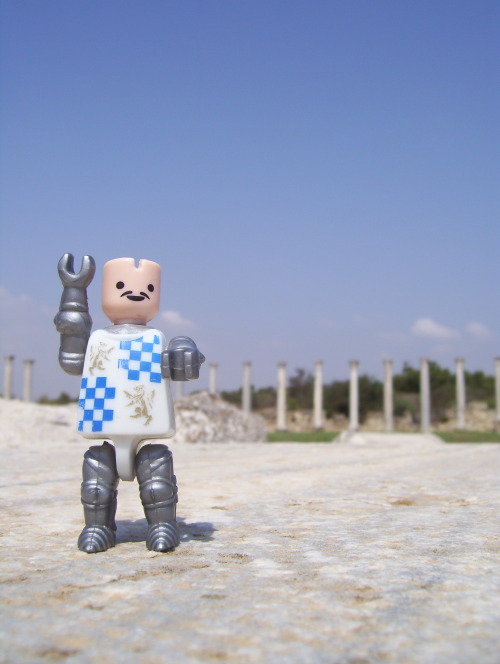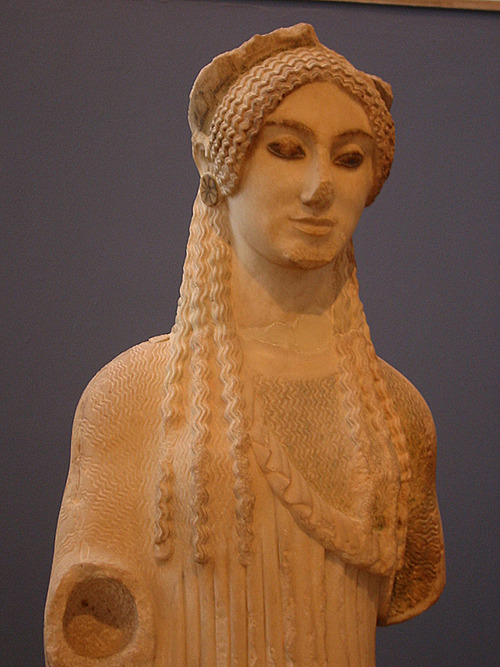#greek archaeology
An Archaeological Wonder: Salamis
Salamis, Northern Cyprus
I had the opportunity to explore these amazing ruins while traveling around Cyprus. You can wander around the archaeological site and easily imagine the bustling city it once was. Salamis became the ancient capital of Cyprus as far back as 1100 BC and was occupied by a number of civilizations. The site is approximately one square mile. Parts of the site were built by Trajan and Hadrian, particularly after an earthquake in 76 AD. The Romans built baths, mosaics, etc. The city was destroyed by an invasion around 674 AD, forcing the occupants to the area around Famagusta. The site was looted constantly until 1952 until 1952, when excavations by the Department of Antiquities began. Personally, I think this site should be designated as an UNESCO World Heritage Site.
Post link

Mary Ellingson (1906-1993), nee Ross, was an archaeologist who made important contributions to the study of ancient Greek terracotta figurines but who never received credit for her work. A graduate in classics from the University of Alberta, Ellingson came to Johns Hopkins University to study under David Robinson in 1930. Robinson was preparing for his second season of excavation at the Greek site of Olynthos and asked Ellingson to join the staff the following year. Robinson was one of the first classical archaeologists to excavate houses and to search for evidence of Greek private life; the 14 Excavations at Olynthus are his legacy. Ellingson supervised the excavations of several houses and a cemetery managing up to 60 Greek workmen at a time. She also kept her own records, independent of the excavation records, of all the terracotta figurines discovered during the season. Her master’s thesis is unusual for its day in that in addition to the typical chronological catalog of figurines, Ellingson included an analysis of their find spots. Prior to her work it was believed the figurines were for use in cemeteries or temples; Ellingson was able to demonstrate that the ancient Greeks used them in household shrines, as domestic decorations, and even as toys. Her dissertation was an expansion of her master’s thesis to include terracotta figurines found in other seasons at Olynthos and also at other sites in northern Greece and the Balkans. Shortly after receiving her PhD in classical archaeology from Johns Hopkins, Ellingson married and, although she tried to publish her work, the disruptions of World War II and motherhood combined to make sure she never achieved her goal.
Ellingson never received credit for her work. Without seeking her permission or mentioning her contribution, Robinson published her master’s thesis as volume VII in the Excavations at Olynthus series and her dissertation as the first chapter and a half of volume XIV. Reviewers praised Robinson’s insights in both works, not realizing he had not written them. Ellingson returned to academia in the 1960s becoming a full professor at the University of Evansville and retiring in 1974. She never revealed the secret of her contributions to the Excavations at Olynthus series to anyone in the field.
Post submitted by Alan Kaiser
Edited by Brenna
More Information:
Kaiser, Alan. 2014. Archaeology, Sexism, and Scandal. The Long-Suppressed Story of One Woman’s Discoveries and the Man Who Stole Credit for Them. Lanham, MD: Rowman and Littlefield.*
Olynthus 1931: The Mary Ross Ellingson Photo Archive
*Psst…Read the accompanying book review on trowelblazers.com
Today, I’ll be making a quick and easy sesame snack from the Cretan Iron Age! A treat so sweet that it’s still popular today (with a few adaptations of course) - the koptoplakous as it’s known in antiquity - or the Pasteli as it’s known today!
In any case, let’s now take a look at The World That Was! Follow along with my YouTube video above!
Ingredients
200g sesame seeds
200g honey
sea salt (to taste)
Method
1 - Toast the Sesame Seeds
To begin with, we need to lightly brown and toast 200g of sesame seeds. Do this by tossing them into a hot pan, and letting them cook over a high heat for a couple of minutes. Don’t let these sit still, keep them moving around the pan so they toast evenly! Do this for about 5 minutes, or until your seeds are nutty and fragrant.
Take these off the heat, but keep them warm while you deal with the honey.
2 - Boil Honey
Next, place a pot onto a high heat. Into this, scoop about 200g of honey and let it heat up. Keep stirring it occasionally with a wooden spoon, so it doesn’t burn. Let this cook away over high heat until it foams up significantly. Much like boiling milk, this will happen very quickly, and might catch you off-guard. If it looks like it’s getting too high, take it off the heat and it’ll cool down pretty quickly.
3 - Mix Honey and Sesame
After about 10 minutes of foaming, turn the heat down to low before tossing in your toasted sesame seeds. Stir all of this together and let it cook for another 5 - 10 minutes. The honey should start to turn a deeper golden brown, but if it gets too dark, take it off the heat immediately.
When it’s been mixed together, pour it out onto a baking tray lined with paper. Spread it out into a fairly thin layer, but not too thin! Let it sit like this for about 20 minutes or so, before slicing it into segments with a knife.
You can serve this up whenever it’s cooled like this, or leave them overnight to re-solidify a little more! Either way, the finished dish is super sweet, and has a delicious nutty flavour, thanks to the toasted sesame seeds.
The modern name for this dish - pasteli - has its origins in medieval Italian cuisine, as this kind of sweet treat is common throughout Europe, the Near East, Asia, and the Indian subcontinent. Though obviously, each region has its own takes on this basic formula, such as the addition of local spices, nuts, or other ingredients!
Krater from the Geometric Period, terracotta, ca. 750-730BC, Greece.
Monumental vases like this one were used as grave markers during the Geometric Period (kraters for men and amphoras for women). On the largest part of the vase is depicted a scene called “prothêsis” in which the deceased is laid on a bier and surrounded by mourners. The mourners are represented with the hands on their heads because it symbolises their wailing. The charriots and shields depicted under the prothêsis are probably there to show that the deceased had a powerful ancestry.
Courtesy of Metmuseum.
Post link
Kore 674, paros marble sculpture from the archaic age, Athens, ca 500 BC.
This sculpture from the archaic age depicts a young woman wearing the chiton and the himation. It’s often called ‘the delicata’ because of its very delicate and beautiful features. The smile on her face is also typical of the archaic style in greek art.
photo credit: wikipedia.
Post link
Limestone sculpture, Imperial Period, A.D. 150–200, Syria.
An elaborate Palmyrene funerary monument with a Greek inscription “Aththaia, daughter of Malchos, Happy One, Farewell”. Although the Greek inscription betrays her Hellenic affinities, her face and the details of carving are thoroughly Eastern. The incised relief line of the eyebrows and the rubbery folds of the neck foreshadow Graeco-Buddhist sculpture in northern and northwestern India, and central Asia. The carving of the chiton (tunic) and himation is expertly handled, but the number of tight zigzag folds also foreshadows Late Antique and Byzantine art. - mfa.org (text and photo)
Post link










